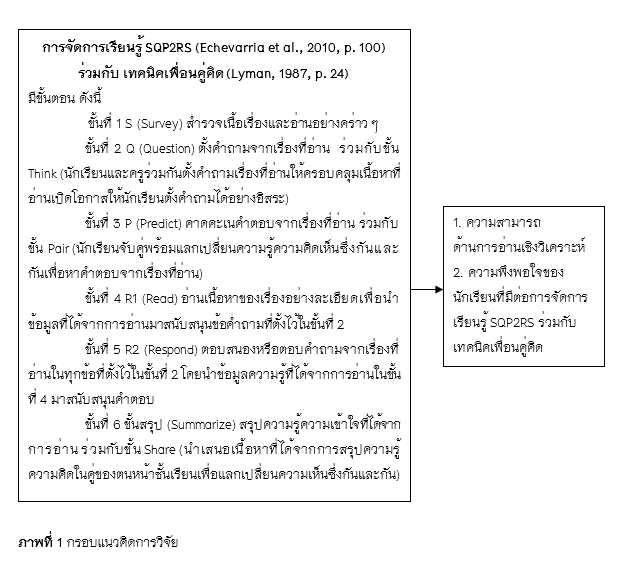The Development of the Analytical Reading Ability of Matthayomsueksa 2 Student Using Sqp2Rs Strategy with Think-Pair-Share Techiques
Main Article Content
Abstract
The purpose of this Quasi-Experimental Design Research were: 1) to compare analytical reading ability of Matthayomsueksa 2 student before and after using the SQP2RS method combined with the Think-Pair-Share method, 2) to compare analytical reading ability of 2nd secondary school students by using the SQP2RS method combination with the Think-Pair-Share method and 70 % criterion, and 3) to study the satisfaction of Matthayomsueksa 2 student with SQP2RS learning management combined with the Think-Pair-Share method. The participants of this study were fifteen Matthayomsueksa 2 student at Watnongnadampittaya School, Mueang District, Phichit Province, Phichit Primally Educational Service Area Office 1, Semester 2, 2023 Academic Years from cluster random sampling. This research used the SQP2RS Method with the Think-Pair-Share method, Including testing of analytical reading ability and learning satisfaction survey. Statistics used in data analysis consisted of mean, standard deviation.
The result of the research found that: 1) analytical reading ability of Matthayomsueksa 2 student were better than before studying, 2) scores of testing of analytical reading ability were higher than the criterion 70%, and 3) the result of satisfaction survey with the SQP2RS method and Think-Pair-Share method to develop analytical reading ability was at high level.
Downloads
Article Details

This work is licensed under a Creative Commons Attribution-NonCommercial-NoDerivatives 4.0 International License.
The articles published are copyrighted by the Graduate School, Chiang Mai Rajabhat University.
The opinions expressed in each article of this academic journal are solely those of the individual authors and do not reflect the views of Chiang Mai Rajabhat University or its faculty members. The responsibility for the content of each article rests entirely with the respective authors. In the event of any errors, the authors alone are responsible for their own articles.
References
Chanraninprom, S. (2018). The development of the analytical reading ability of Matthayomsuksa 2 student using SQP2RS strategy with mind mapping. (Master's thesis, Teaching Thai Language, Silpakorn University). [In Thai]
Chitchayavanich, K. (2019). Learning management. Bangkok: Chulalongkorn University. [In Thai]
Chottanakit, S. (2018). Development of Thai reading comprehension activity package using SQ4R reading method together with think pair share for Mathayomsuksa 1 students. (Master's thesis, Curriculum and Instruction, Burapha University). [In Thai]
Echevarria, J. & Vogt, M. (2008). 99 Ideas and activities for teaching English learners with the SIOP model. Boston: Allyn and Bacon.
Echevarria, J., Vogt, M., & Short, D.J. (2010). Making content comprehensible for secondary English learners: The SIOP model. Boston: Allyn and Bacon.
Evaluation Affair of Watnongnadampittaya School. (2021). The report result of reading and writing ability screenings of grade 1 – 6 students from Bannamrin School. Phichit: Watnongnadampittaya School. [In Thai]
Fauziyati, D., & W. Istianah. (2013). The effect of using think-pair-share technique on the eight grade students' reading comprehension achievement at SMPN 3 Bangsalsari Jember. (Master’s thesis, Department of Education, University of Jember).
Hamdan, R. K. A. (2017). The effect of (Think-Pair-Share) strategy on the achievement of third grade student in Sciences in the Educational District of Irbid. Journal of Education and Practice, 8(9), 88-95. Retrieved from https://files.eric.ed.gov/fulltext/EJ1139082.pdf
Jaisomwang, E. (2022). A study of critical reading achievement for Mathayomsuksa 5 students using concept-oriented reading instruction and SQP2RS strategy. (Master's thesis, Teaching Thai Language, Silpakorn University). [In Thai]
Kalapong, S. (2019). The effect of using SQP2RS strategy as reading activity for develop the ability of critical reading in grade 10 students. (Master’s Independent Study, Thai Language, Srinakarinwirot University). [In Thai]
Komonkitisakul, P. (2022). The development of reading comprehension abilities of Mathayomsuksa 2 students with OK5R learning management in conjunction with the think-pair-share technique. (Master’s Independent Study, Thai Language, Naresuan University). [In Thai]
Kawinthanacharoen, T. (2020). The development of critical reading ability and teamwork of Matthayomsuksa 4 student by organizing learning activities using AQP2RS strategy. (Master's thesis, Curriculum and Instruction, Silpakorn University). [In Thai]
Koonkaew, A. (2022). New approaches to test measurement and evaluation. Phetchabun: Phetchabun Rajabhat University. [In Thai]
Lyman, F. (1987). Think-pair-share: An ending teaching technique. United States of American: MAA-CIE Cooperative News.
Ministry of Education. (2007). Thai language teaching and learning for thinking development. Bangkok: Thai Language Institute Department of Academics and Educational Standards, Office of the Basic Education Commission. [In Thai]
Ministry of Education. (2018). Education in Thailand 2018. Retrieved form http://pmnk.kkzone1.go.th/data/news3/24-02-2019-17-34-35_1344028011.pdf [In Thai]
Oodcommee, T. (2022). Developing reading comprehension skill using peer learning management (Think-pair-share) together with the idea of using questions for grade 2 student. (Master’s Independent Study, Thai Language, Naresuan University). [In Thai]
Puangsuk, T. (2015). Comparison of the ability to read on instruction entitled spelling of word ending do not follow the rules for Grade 2 by computer-assisted of think-pair-share with normal teaching method. Buriram: Rajabhat University Buriram. [In Thai]
Prombud, R. (2021). The development of reading comprehension ability for grade 7 students by using think-pair-share techniques and questions. (Master's thesis, Curriculum and Instruction, Silpakorn University). [In Thai]
Thongniam, S. (2017). Thai language for communication. Bangkok: Se-Education.
Wadeecharoen, W., Lertnaisat, R., and Teekasap, S. (2017). Research methodology: Concept to practice. Bangkok: SE Education Public Company Limited. [In Thai]


